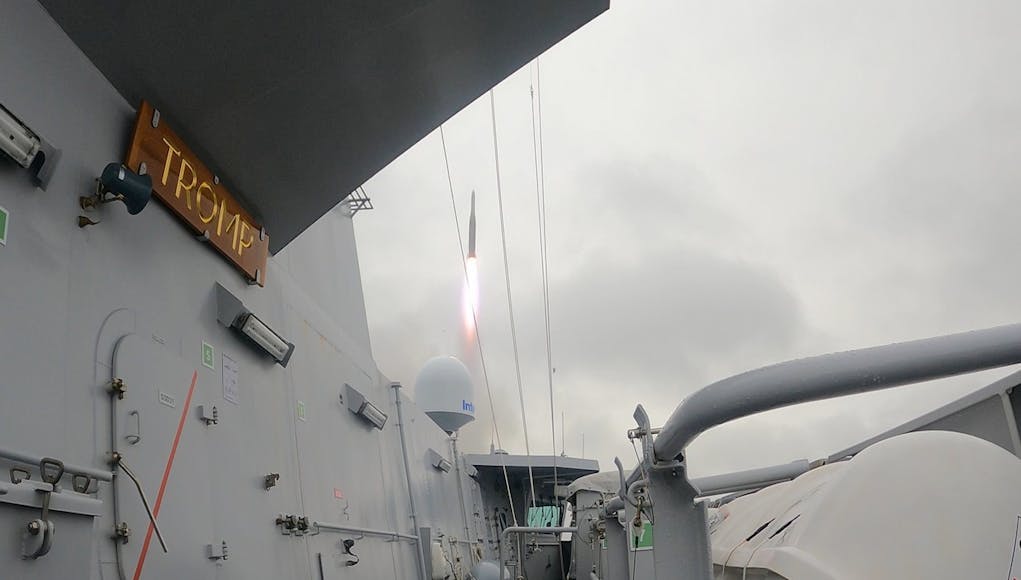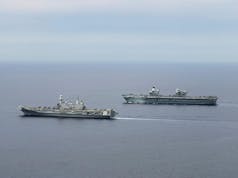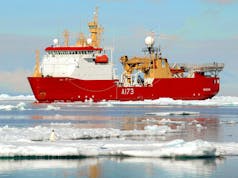HNLMS Tromp recently visited the Hebrides Missile Range off the coast of Scotland in order to conduct live firings of her air defence missiles.
HNLMS Tromp is the flagship of Standing NATO Maritime Group One (SNMG1). According to the Royal Navy here, the Standing NATO Maritime Groups are an integrated multinational maritime force made up of vessels from the various allied nations.
“These vessels are permanently available to NATO and perform a range of different tasks, from participating in exercises to intervening in operational missions. They also provide NATO with a continuous maritime capability for operations and other activities, both in peacetime and in periods of crisis and conflict.
Standing NATO Maritime Group 1 and Standing NATO Maritime Group 2 are normally deployed to the Atlantic and Mediterranean regions, respectively – although both are available for deployment wherever they may be required.”
SNMG1 consists of four to six destroyers and frigates. Its role is to provide NATO with an immediate operational response capability.
Flagship HNLMS Tromp had a successful training week: launching missiles🚀 near Scottish Hebrides. These valuable exercises ensuring a high state of readiness. #WeAreNATO #DeterandDefend 🇳🇴🇩🇰🇳🇱🇫🇷 pic.twitter.com/piP7KRNh6q
— COM SNMG1 (@COM_SNMG1) October 23, 2022
The frigate was recently in Glasgow.
Unique landscape
On the island of South Uist in the Outer Hebrides is where you’ll find the missile range. The missiles are monitored from an island in Scotland known as St. Kilda, which is currently devoid of inhabitants and is rented by the Ministry of Defence.
The site is managed by QinetiQ, which was formerly a department within the Ministry of Defence but was later privatised. Across the various locations of the range, there are approximately 230 employees.
In 1987, St. Kilda was designated as Scotland’s first ever World Heritage Site. The United Kingdom’s Ministry of Defence established the facility in 1957 in order to conduct tests on nuclear missiles. In response to the opposition to the construction of the range, Sir Compton Mackenzie wrote the novel Rockets Galore!, which was later adapted into a movie that was shot on the island of Barra.
Rising use of the weapons range
The Range occupies 115,000km² of sanitised airspace with unlimited altitude. This large area and its nearby airfield make it ideal for air-launched weapons operations, and by implication, is suitable for rocket engine testing. The missile testing range recorded one of its busiest years towards the end of the last decade as NATO combat aircraft and vessels decided to take advantage of the unique facility.
Data released to the Press and Journal shows that 12 different types of missile were used at the Uist facility in 2017/18.
They included the US Navy’s surface-to-air SM-2, SM-3 and SM-6 weapons, which can shoot down enemy aircraft or missiles, as well as the AQM-37C, which is a supersonic drone used to test the SM missiles.
A vital facility for Europe and NATO
In addition, rockets from the United States, known as the Terrier Oriole and the Terrier Orion, were fired from the Hebrides Range in 2017, acting in the capacity of ballistic missiles during training exercises. The only other time a Terrier Orion missile has ever been launched from this location was during a war games event in 2015. At that time, it made history by becoming the first ever space vehicle to lift-off from UK soil and leave the Earth’s atmosphere.
Other systems, such as the Rapier surface-to-air missile used by the Royal Air Force, the Sea Ceptor naval missile defence system, the Evolved SeaSparrow missile used by NATO forces, Europe’s Sea Viper, the ASRAAM and AMRAAM air-to-air missiles, and the meteor system, were also tested in 2017. It’s very clear that this range is essential to the defence of the United Kingdom and, by extension, NATO.














I wonder, did that happen to be coincidentally round the time Tromp was shadowing Akademik Boris Petrov
Off topic but we motored into harbour astern of an Arleigh-Burke yesterday – plenty of activity with other vessels also. From where I am currently I can see two very impressive aircraft carriers – three if you count a museum ship. Not much chance of being bored the next few days.
Mick
What is the museum ship?
USS Midway
Also was passed by an Independence Class heading the other way. Equally impressive.
Wasn’t Rapier transferred to the Royal Artillery from the RAF reg a while back?
Yes. Decision announced in July 2005 and implemented from 2006. Not sure why they did it.
RAF regiment were being ‘modernised’…..
It was a hang over from the Bloodhound control arguments that RAF regiment used Rapier in the first place…..
It does make some kind of sense that RAF had something to protect airfields.
Equally it makes a lot of sense for RA to have something to protect the battlefield.
I never had much time for Rapier. It was a system with great promise that never failed to disappoint when it was tested to the max.
Thanks for the answer. Rapier replaced Bloodhound in the RAF Regt and Thunderbird in the Army. Both needed air defence capability, as you say.
RAF Regt giving up Rapier meant that they could not provide GBAD to an airfield – makes no sense to me. That was a large part of their raison d’etre.
Who provides AD for RAF airfields now – the RA? I know they did/do in FI but is this universal?
I take your point about Rapier being poor in the early days – bad reputataion in the Falklands Conflict but I assumed it had got better up to and including Field Standard C.
“Not sure why they did it.”
Because it was something to cut as the enemy in the deserts had no airpower and politicians cannot see beyond the end of their nose, but want to save money on defence.
So a good chunk of the GBAD force was cut, along with most of the TA AD regiments.
Not really, as the Army operated Rapier already alongside the RAF Regiment.
So “transferred” is a nice flowery way of describing a cut, typical MoD spin.
I suppose the British version of the above would be a TEWT
Tromp is doing the rounds recently. Very nice to see the Netherlands sailing around. Shame about the name. Can’t help but think of trump. Maybe he has Dutch cousin that likes a smoke and a pancake.
A guy I worked with kept asking me would I come and do a couple of weeks catering on st kilda. Helicopter trip in and out. A bit lonely for me I think
Restauranteur? Chef? Small ditch to traverse between thee and me, but suppose I could order some carryout. 🤔😉😁
Do appreciate these type of articles. Infrastructure projects and capability building and testing. Anything below the headline grabbing pointy end that ensures all else operates. There are some eye opening but generally quiet projects out there.
Very interesting video from Israel on how they expect their ship defence sysytems to work:
St Kilda is the patron saint of spoofs and decoys.
Off thread, but, of interest:
https://www.euronews.com/2022/10/23/fears-grow-as-more-suspicious-drones-appear-above-norways-offshore-facilities
Notice that Norway even considers it might already be at war. Article 5 in a blink at this rate.